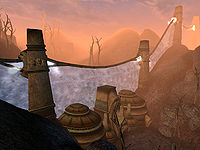Lore:Ghostfence
| This page is currently being redesigned for the Lore Places Project (LPP). The page may need work to meet the standards outlined on the project page. |
| This page or parts of this page were previously transcluded to other pages per this discussion. This page should be checked for potential unrelated lore and other information. Please remove this banner when the page has been cleaned up. |
| Ghostfence | |
|---|---|
| Type | Landmark |
| Continent | Tamriel |
| Province | Morrowind |
| Region | Vvardenfell |
| Appears in | Morrowind |
The Great Ghost Fence (usually shortened to simply the Ghostfence)[1] was an enormous shield-like wall surrounding the crater of Red Mountain. Developed to keep The Blight and Corprus monsters contained within the Red Mountain Region,[2] it was sustained by the Tribunal's combined powers. If it had not existed, it is reasonable to assume that the Blight and Corprus would have reached all areas of Vvardenfell. It was constructed in a similar style to that of standard Temple architecture. Its pillars were able to channel the holy energies of the Tribunal and the spirits of the deceased, converting them into a great impenetrable shield.[2] Except for the tunnel through Kogoruhn, the only entrance to the Red Mountain Region was at the gate citadel of Ghostgate, although it was possible to levitate over the fence, and cliff racers were able to fly over it.[3]
When the Great Ghost Fence was erected is vague. It already existed shortly after the Armistice was signed[2] sometime in the final years of the Second Era.[4][5] It was already centuries old[6][1] by the end of the Third Era, though the period around 3E 417 is vaguely known as "the time of the Ghostfence".[7]
Those undergoing the Pilgrimages of the Seven Graces must pass through the Ghostfence to visit the Shrine of Pride. The Ghostgate served as a rest for Pilgrims.[8]
HistoryEdit
Following his reawakening in 2E 882, Dagoth Ur bound himself to the Heart of Lorkhan, the source of the Tribunal's power, and started a theocracy in Morrowind based on the worship of the new-born god Akulakhan.[9] Later that same year, Dagoth Ur and his ash vampires ambushed the Tribunal during their annual ritual of bathing in the heart's power, driving them away and preventing them from restoring themselves with Kagrenac's tools. In the years that followed, while Dagoth Ur attempted to spread Corprus disease and the Blight throughout Vvardenfell from his fortress in the crater of Red Mountain, the Tribunal launched intermittent campaigns against the fortress, seeking to force access to the Heart Chamber.[9] While some of these campaigns were successful, and Dagoth Ur and his kin were slain, the Heart always revived them in time. When the Tribunal realized that they couldn't destroy him, they created the Ghostfence to contain the threat.[10] They also erected the Ghostgate so that they and others would have access to Red Mountain. They stationed Ordinators of House Indoril and Buoyant Armigers to guard the gate. Unfortunately, the Tribunal were required to constantly focus a portion of their power on the fence to sustain it.
The Tribunal's power was severely weakened in 3E 417 after Dagoth Ur managed to capture two of Kagrenac's tools, Keening and Sunder. Combined with the increasing effort required to sustain the Ghostfence, all three Tribunes became increasingly reclusive.[9] Vivec had been a very public figure in Morrowind until this event.
According to Ancestors and the Dunmer, the Tribunal incorporated the bones of many Dunmeri ancestors into the Ghostfence. The Temple discouraged private or clan burials as selfish, with the result that the vast majority of ancestors' remains were used to strengthen the Ghostfence instead. This may be one example of how the Tribunal and the Temple altered traditional religious and burial practices as part of their fight against Dagoth Ur.[2]
After Dagoth Ur's DefeatEdit
Following the downfall of Dagoth Ur, Red Mountain stopped spreading the Blight, and conditions in the area were much the same as the rest of Vvardenfell. The Ghostfence itself remained; however, the shield that it once produced became unnecessary, and was deactivated.[11] Ghostgate had not been retired—it and the Ghostfence's structure remained as a reminder of the Nerevarine and the defeat of Dagoth Ur, as well as a tribute to the Tribunal, and to the Buoyant Armigers and Ordinators that died.[1]
It is unknown what became of the Ghostfence with the coming of the Red Year.
See AlsoEdit
- For game-specific information on the Ghostfence, see the Morrowind article.
ReferencesEdit
- ^ a b c Generic Dialogue G in Morrowind
- ^ a b c d Ancestors and the Dunmer
- ^ Events of Morrowind
- ^ The Arcturian Heresy — The Underking, Ysmir Kingmaker
- ^ Artisa Arelas' dialogue in Morrowind
- ^ A Short History of Morrowind — Jeanette Sitte
- ^ Mehra Helas' dialogue in Tribunal
- ^ The Pilgrim's Path — Tribunal Temple
- ^ a b c Dagoth Ur's Plans — Tribunal Temple
- ^ Vivec's dialogue in Morrowind
- ^ The Citadels of the Sixth House quest in Morrowind
